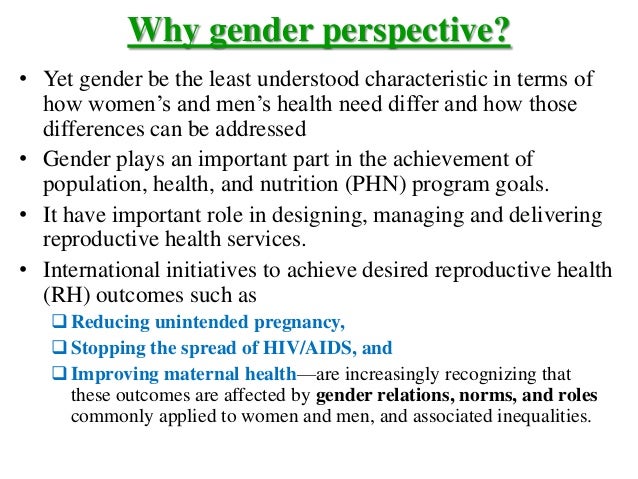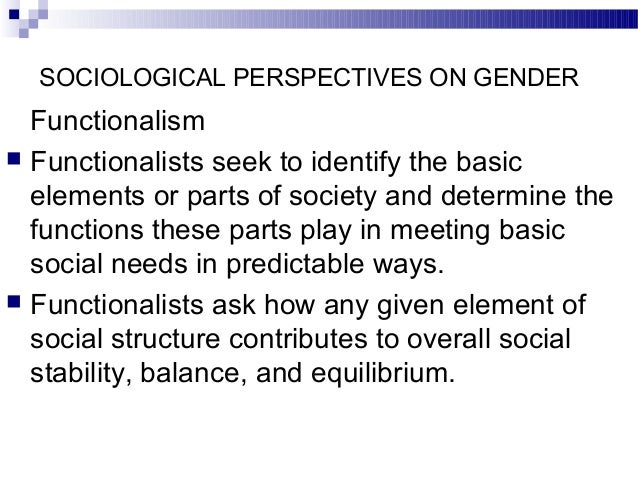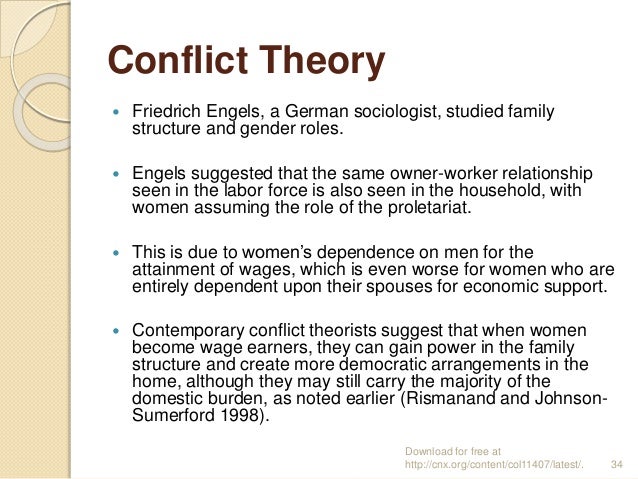Relevance: Sociology: Stratification and Mobility:Dimensions – Social stratification of class, status groups, gender, ethnicity and race



The Functionalist Perspective

The functionalist perspective of gender roles suggests that gender roles exist to maximize social efficiency.
KEY TAKEAWAYS
Key Points
- The functionalist perspective sees society as a complex system whose parts work together to promote solidarity and stability. This approach looks at society through a macro-level orientation and broadly focuses on the social structures that shape society as a whole.
- This theory suggests that gender inequalities exist as an efficient way to create a division of labor, or as a social system in which a particular segment of the population is clearly responsible for certain acts of labor and another segment is clearly responsible for other labor acts.
- The feminist movement takes the position that functionalism neglects the suppression of women within the family structure.
Key Terms
- functionalist perspective of gender inequality: A theory that suggests that gender inequalities exist as an efficient way to create a division of labor, or a social system in which a particular segment of the population is clearly responsible for certain acts of labor and another segment is clearly responsible for other labor acts.
- The Functionalist Perspective: A broad social theory that sees society as a complex system whose parts work together to promote solidarity and stability.
- Division of labor: A division of labour is the dividing and specializing of cooperative labour into specifically circumscribed tasks and roles.
The functionalist perspective sees society as a complex system whose parts work together to promote solidarity and stability. This approach looks at society through a macro-level orientation, which is a broad focus on the social structures that shape society as a whole, and looks at both social structure and social functions. Functionalism addresses society as a whole in terms of the function of its constituent elements, namely: norms, customs, traditions, and institutions. A common analogy, popularized by Herbert Spencer, presents these parts of society as “organs” that work toward the proper functioning of the “body” as a whole.
The functionalist perspective of gender inequality was most robustly articulated in the 1940s and 1950s, and largely developed by Talcott Parsons’ model of the nuclear family.
This theory suggests that gender inequalities exist as an efficient way to create a division of labor, or as a social system in which particular segments are clearly responsible for certain, respective acts of labor. The division of labor works to maximize resources and efficiency.
A structural functionalist view of gender inequality applies the division of labor to view predefined gender roles as complementary: women take care of the home while men provide for the family. Thus gender, like other social institutions, contributes to the stability of society as a whole.

In sociological research, functional prerequisites are the basic needs (food, shelter, clothing, and money) that an individual requires to live above the poverty line.
Functional prerequisites may also refer to the factors that allow a society to maintain social order. According to structural functionalists, gender serves to maintain social order by providing and ensuring the stability of such functional prerequisites.
This view has been criticized for reifying, rather than reflecting, gender roles. While gender roles, according to the functionalist perspective, are beneficial in that they contribute to stable social relations, many argue that gender roles are discriminatory and should not be upheld. The feminist movement, which was on the rise at the same time that functionalism began to decline, takes the position that functionalism neglects the suppression of women within the family structure.
The Conflict Perspective
Conflict theory suggests that men, as the dominant gender, subordinate women in order to maintain power and privilege in society.

KEY TAKEAWAYS
Key Points
- Conflict theory asserts that social problems occur when dominant groups mistreat subordinate ones, and thus advocates for a balance of power between genders.
- Frederich Engels compared the family structure to the relationship between the bourgeoisie and the proletariat, suggesting that women had less power than men in the household because they were dependent on them for wages.
- Men, like any other group with a power or wealth advantage in Conflict Theory, fought to maintain their control over resources (in this case, political and economic power). Conflict between the two groups caused things like the Women’s Suffrage Movement and was responsible for social change.
Key Terms
- subordinate: To make subservient.
- dominant: Ruling; governing; prevailing; controlling.
- proletariat: the working class or lower class
- dominant group: a sociological category that holds the majority of authority and power over other social groups
According to conflict theory, society is defined by a struggle for dominance among social groups that compete for scarce resources. In the context of gender, conflict theory argues that gender is best understood as men attempting to maintain power and privilege to the detriment of women. Therefore, men can be seen as the dominant group and women as the subordinate group.
While certain gender roles may have been appropriate in a hunter-gatherer society, conflict theorists argue that the only reason these roles persist is because the dominant group naturally works to maintain their power and status.
According to conflict theory, social problems are created when dominant groups exploit or oppress subordinate groups. Therefore, their approach is normative in that it prescribes changes to the power structure, advocating a balance of power between genders.
In most cultures, men have historically held most of the world’s resources. Until relatively recently, women in Western cultures could not vote or hold property, making them entirely dependent on men. Men, like any other group with a power or wealth advantage, fought to maintain their control over resources (in this case, political and economic power). Conflict between the two groups caused things like the Women’s Suffrage Movement and was responsible for social change.
Friedrich Engels, a German sociologist, studied family structure and gender roles from a Marxist perspective. Engels suggested that the same owner-worker relationship seen in the labor force could also be seen in the household, with women assuming the role of the proletariat.
This was due to women’s dependence on men for the attainment of wages. Contemporary conflict theorists suggest that when women become wage earners, they gain power in the family structure and create more democratic arrangements in the home, although they may still carry the majority of the domestic burden.
The Interactionist Perspective
From a symbolic interactionist perspective, gender is produced and reinforced through daily interactions and the use of symbols.
KEY TAKEAWAYS
Key Points
- Scholars of interactionism study how individuals act within society and believe that meaning is produced through interactions.
- According to interactionists, gender stratification exists because people act toward each other on the basis of the meanings they have for each other, and that these meanings are derived from social interaction.
- According to Cooley’s concept of the “looking-glass self,” an individual’s understanding of their gender role is based on how society perceives them. Thus, if society views a man as masculine, he will also perceive himself to be masculine.
- “Doing gender” is the notion that masculinity and feminity are performed gender identities. Gender is something we do or perform, not something we are.
Key Terms
- femininity: the sum of all attributes that convey (or are perceived to convey) womanhood
- masculinity: the degree or property of being masculine or manly; manliness
- Charles H. Cooley: an early twentieth century sociologist who developed the idea of the “looking-glass self”
Interactionism
In sociology, interactionism is a theoretical perspective that understands social processes (such as conflict, cooperation, identity formation) as emerging from human interaction. Scholars of this perspective study how individuals act within society, and believe that meaning is produced through the interactions of individuals.
According to interactionists, gender stratification exists because people act toward each other on the basis of the meanings they have for one another. Interactionists believe that these meanings are derived through social interaction, and that these meanings are managed and transformed through an interpretive process that people use to make sense of, and handle, the objects that constitute their social worlds.
The Feminist Perspective
Feminist theory analyzes gender stratification through the intersection of gender, race, and class.
KEY TAKEAWAYS

Key Points
- Gender stratification occurs when gender differences give men greater privilege and power over women, transgender and gender-non-conforming people.
- Feminist theory uses the conflict approach to examine the reinforcement of gender roles and inequalities, highlighting the role of patriarchy in maintaining the oppression of women.
- Feminism focuses on the theory of patriarchy as a system of power that organizes society into a complex of relationships based on the assertion of male supremacy.
- Intersectionality suggests that various forms of oppression– such as racism, classism, and sexism — are interrelated to form a system of oppression in which various forms of discrimination intersect. The theory was first highlighted by Kimberlé Krenshaw.
- Intersectionality suggests that various biological, social, and cultural categories– including gender, race, class, and ethnicity — interact and contribute towards systematic social inequality. Therefore, various forms of oppression do not act independently but are interrelated.
- Mary Ann Weathers drew attention to the ways in which white women face a different form of discrimination than working class women of color, who additionally must fight racism and class oppression.
Key Terms
- patriarchy: The dominance of men in social or cultural systems.
- Intersectionality: The idea that various biological, social, and cultural categories– including gender, race, class, and ethnicity– interact and contribute towards systematic social inequality.
- conflict theory: A social science perspective that holds that stratification is dysfunctional and harmful in society, with inequality perpetuated because it benefits the rich and powerful at the expense of the poor.
In sociology, social stratification occurs when differences lead to greater status, power, or privilege for some groups over others. Simply put, it is a system by which society ranks categories of people in a hierarchy.
Members of society are socially stratified on many levels, including socio-economic status, race, class, ethnicity, religion, ability status, and gender. Gender stratification occurs when gender differences give men greater privilege and power over women, transgender, and gender-non-conforming people.
Feminist theory is the extension of feminism into theoretical or philosophical discourse. It aims to understand the nature of gender inequality, and examines women’s social roles, experiences, and interests. While generally providing a critique of social relations, much of feminist theory also focuses on analyzing gender inequality and the promotion of women’s interests.
Feminist theory uses the conflict approach to examine the reinforcement of gender roles and inequalities. Conflict theory posits that stratification is dysfunctional and harmful in society, with inequality perpetuated because it benefits the rich and powerful at the expense of the poor.
Radical feminism, in particular, evaluates the role of the patriarchy in perpetuating male dominance. In patriarchal societies, the male’s perspective and contributions are considered more valuable, resulting in the silencing and marginalization of the woman. Feminism focuses on the theory of patriarchy as a system of power that organizes society into a complex of relationships based on the assertion of male supremacy.
The feminist perspective of gender stratification more recently takes into account intersectionality, a feminist sociological theory first highlighted by feminist-sociologist Kimberlé Crenshaw.
Intersectionality suggests that various biological, social and cultural categories, including gender, race, class and ethnicity, interact and contribute towards systematic social inequality.
Therefore, various forms of oppression, such as racism or sexism, do not act independently of one another; instead these forms of oppression are interrelated, forming a system of oppression that reflects the “intersection” of multiple forms of discrimination. In light of this theory, the oppression and marginalization of women is thus shaped not only by gender, but by other factors such as race and class.
For more such notes, Articles, News & Views Join our Telegram Channel.
Click the link below to see the details about the UPSC –Civils courses offered by Triumph IAS. https://triumphias.com/pages-all-courses.php


merry christmas!
merry christmas!
lodu same to you